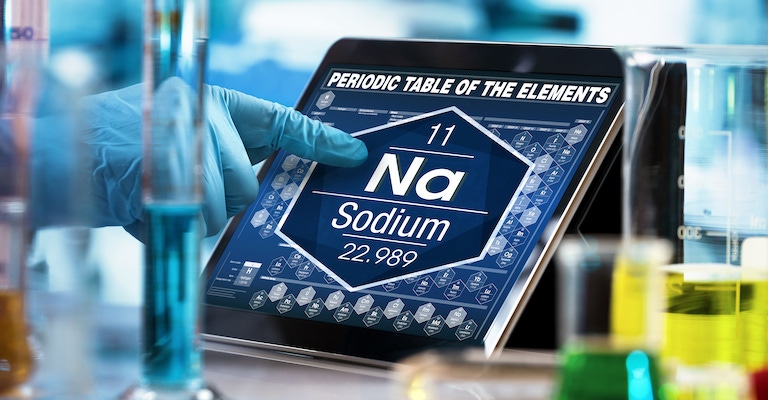A lower temperature molten sodium battery could provide significant advantages for renewable energy storage.
July 23, 2021

In the battery world, most of the attention these days is focused on lithium-ion batteries and their use to power electric vehicles (EVs). But there are other important applications for energy storage including storage to support the power grid and allow the widescale adoption of renewable energy from intermittent resources such as wind and solar. While lithium-ion megapacks are under development for such applications by companies like Tesla, there are other electrochemical battery systems that can be deployed for grid storage. One such is molten sodium.
Molten Sodium
Molten sodium batteries are not new—they have been used for many years to store energy from renewable sources, such as solar and wind. Commercially available molten sodium batteries typically operate in a temperature range of 520-660 degrees Fahrenheit. Researchers at Sandia National Laboratories have designed a new class of molten sodium-iodine batteries for grid-scale energy storage that operate at a much cooler 230 degrees Fahrenheit.
“We’ve been working to bring the operating temperature of molten sodium batteries down as low as physically possible,” said Leo Small, the lead researcher on the project, in a Sandia news release. “There’s a whole cascading cost savings that comes along with lowering the battery temperature. You can use less expensive materials. The batteries need less insulation and the wiring that connects all the batteries can be a lot thinner.” However, the battery chemistry that works at 550 degrees doesn’t work at 230 degrees, he added. Among the major innovations that allowed this lower operating temperature was the development of a catholyte—a liquid mixture of two salts, in this case, sodium iodide and gallium chloride.
How It Works
For the new molten sodium battery, one of the usually solid electrodes is replaced by liquid sodium metal, and the other electrode is replaced by a liquid mixture of sodium iodide and a small amount of gallium chloride, said Erik Spoerke, a materials scientist who has been working on molten sodium batteries for more than a decade.
According to Sandia, “When energy is discharged from the new battery, the sodium metal produces sodium ions and electrons. On the other side, the electrons turn iodine into iodide ions. The sodium ions move across a separator to the other side where they react with the iodide ions to form molten sodium iodide salt.” In the middle of the battery is a special ceramic separator that allows only sodium ions to move from side to side, nothing else.
“In our system, unlike a lithium-ion battery, everything is liquid on the two sides,” Spoerke said. “That means we don’t have to deal with issues like the material undergoing complex phase changes or falling apart; it’s all liquid. Basically, these liquid-based batteries don’t have as limited a lifetime as many other batteries,” he added. Commercial molten sodium batteries have lifetimes of 10-15 years, significantly longer than standard lead-acid batteries or lithium-ion batteries.
Safer
Sodium-iodide batteries are also safer according to Spoerke. “A lithium-ion battery catches on fire when there is a failure inside the battery, leading to runaway overheating of the battery. We’ve proven that cannot happen with our battery chemistry. Our battery, if you were to take the ceramic separator out, and allow the sodium metal to mix with the salts, nothing happens. Certainly, the battery stops working, but there’s no violent chemical reaction or fire,” he said.
“If an outside fire engulfs a sodium-iodide battery, it is likely the battery will crack and fail, but it shouldn’t add fuel to the fire or cause a sodium fire,” Small added.
Higher Energy Density
The new sodium-iodide battery at 3.6 volts has a 40% higher operating voltage than a current commercial molten sodium battery. This voltage leads to higher energy density, and that means that potential future batteries made with this chemistry would need fewer cells, fewer connections between cells, and an overall lower unit cost to store the same amount of electricity, Small said. “We were really excited about how much energy we could potentially cram into the system because of the new catholyte we’re reporting in this paper,” Martha Gross, a postdoctoral researcher added. “Molten sodium batteries have existed for decades, and they’re all over the globe, but no one ever talks about them. So, being able to lower the temperature and come back with some numbers and say, ‘this is a really, really viable system’ is pretty neat,” she said.
The Future
Gallium chloride is very expensive, more than 100 times as expensive as table salt so a next step for the sodium-iodide battery project is to continue to tune and refine the catholyte chemistry to replace the gallium chloride component, Small said.
Spoerke added that it would likely take five to 10 years to get sodium-iodide batteries to market, with most of the remaining challenges being commercialization challenges, rather than technical challenges. “This is the first demonstration of long-term, stable cycling of a low-temperature molten-sodium battery,” Spoerke said. “The magic of what we’ve put together is that we’ve identified salt chemistry and electrochemistry that allow us to operate effectively at 230 degrees Fahrenheit. This low-temperature sodium-iodide configuration is sort of a reinvention of what it means to have a molten sodium battery.”
Kevin Clemens is a Senior Editor with Battery Technology.
About the Author(s)
You May Also Like




